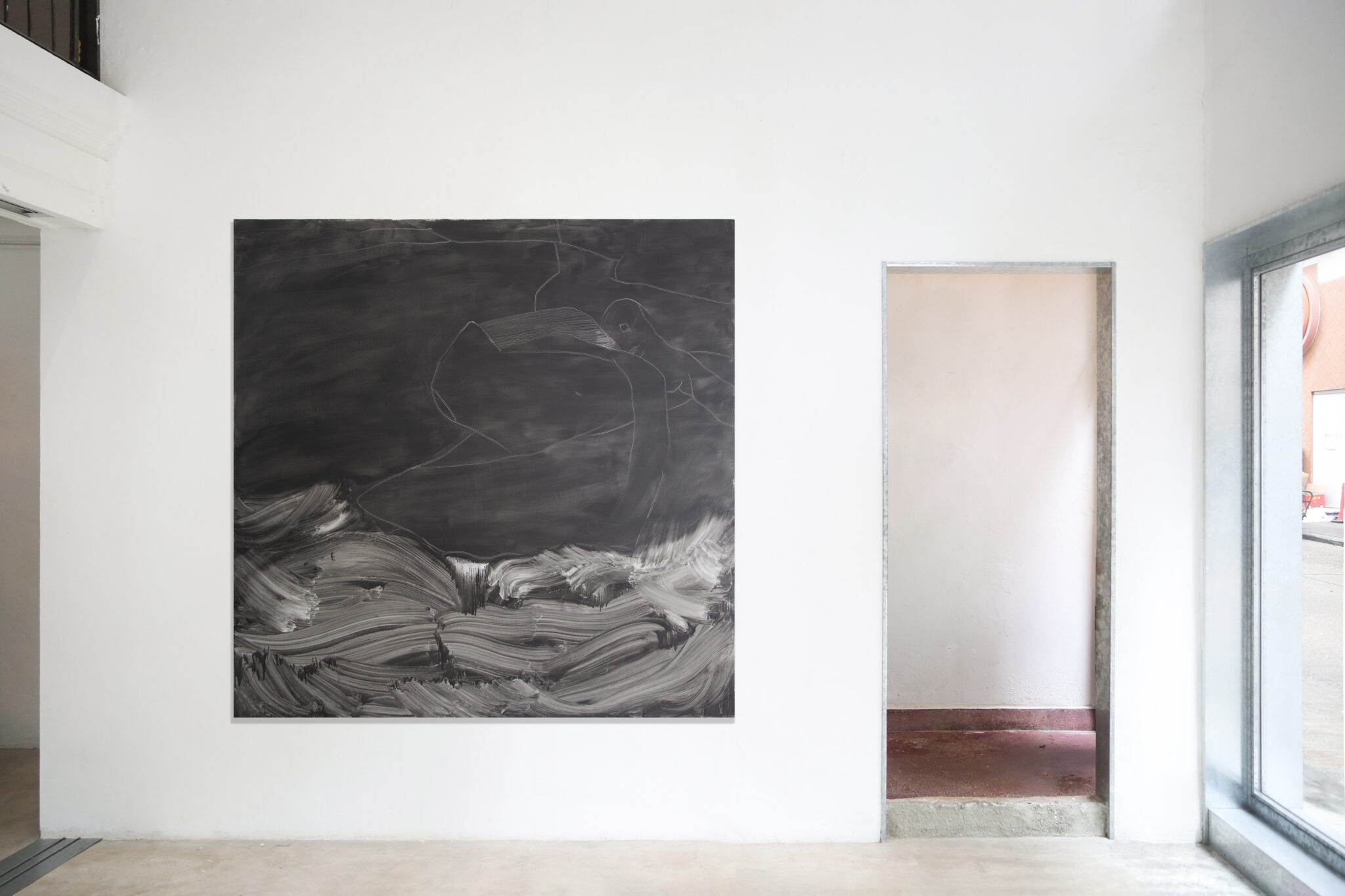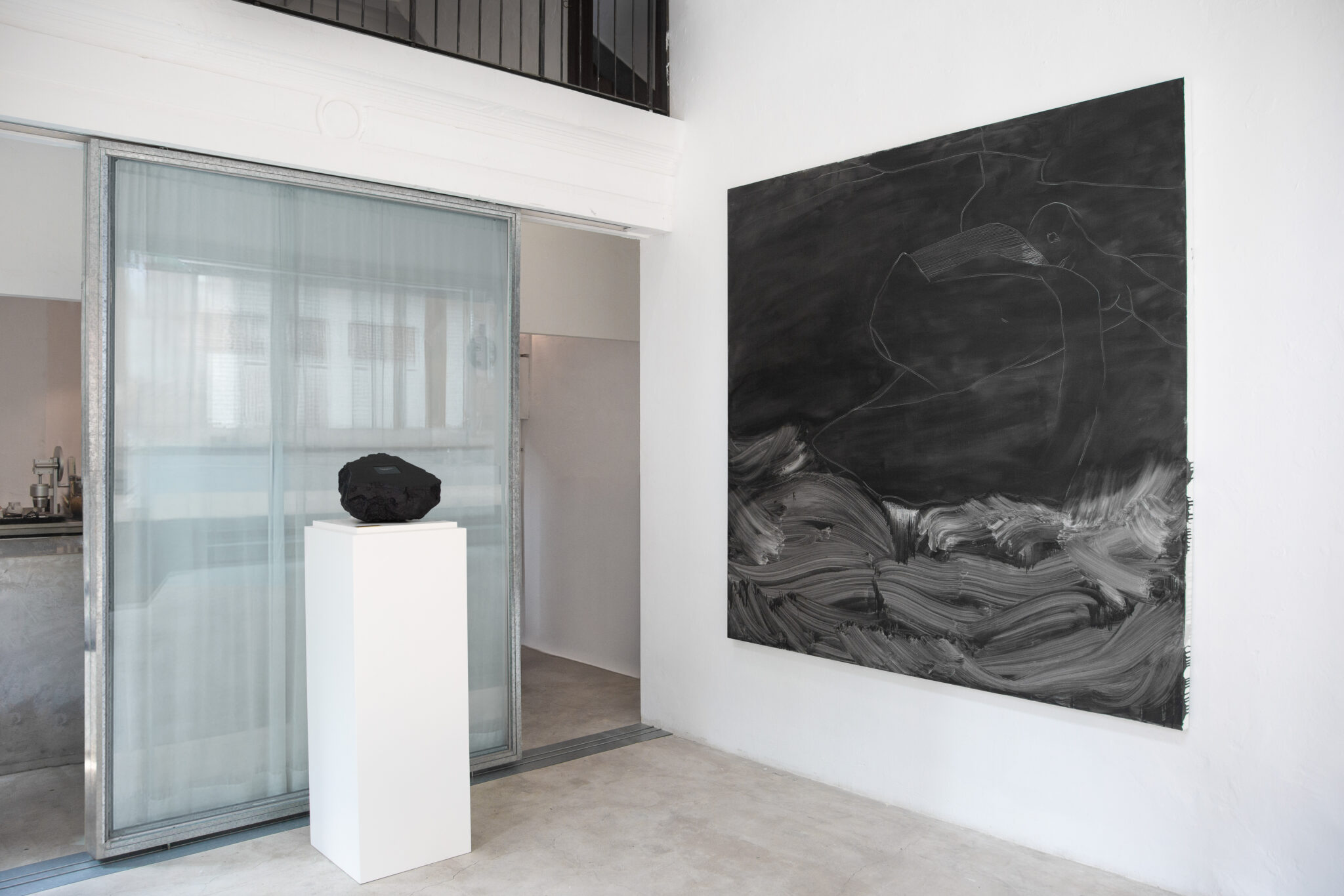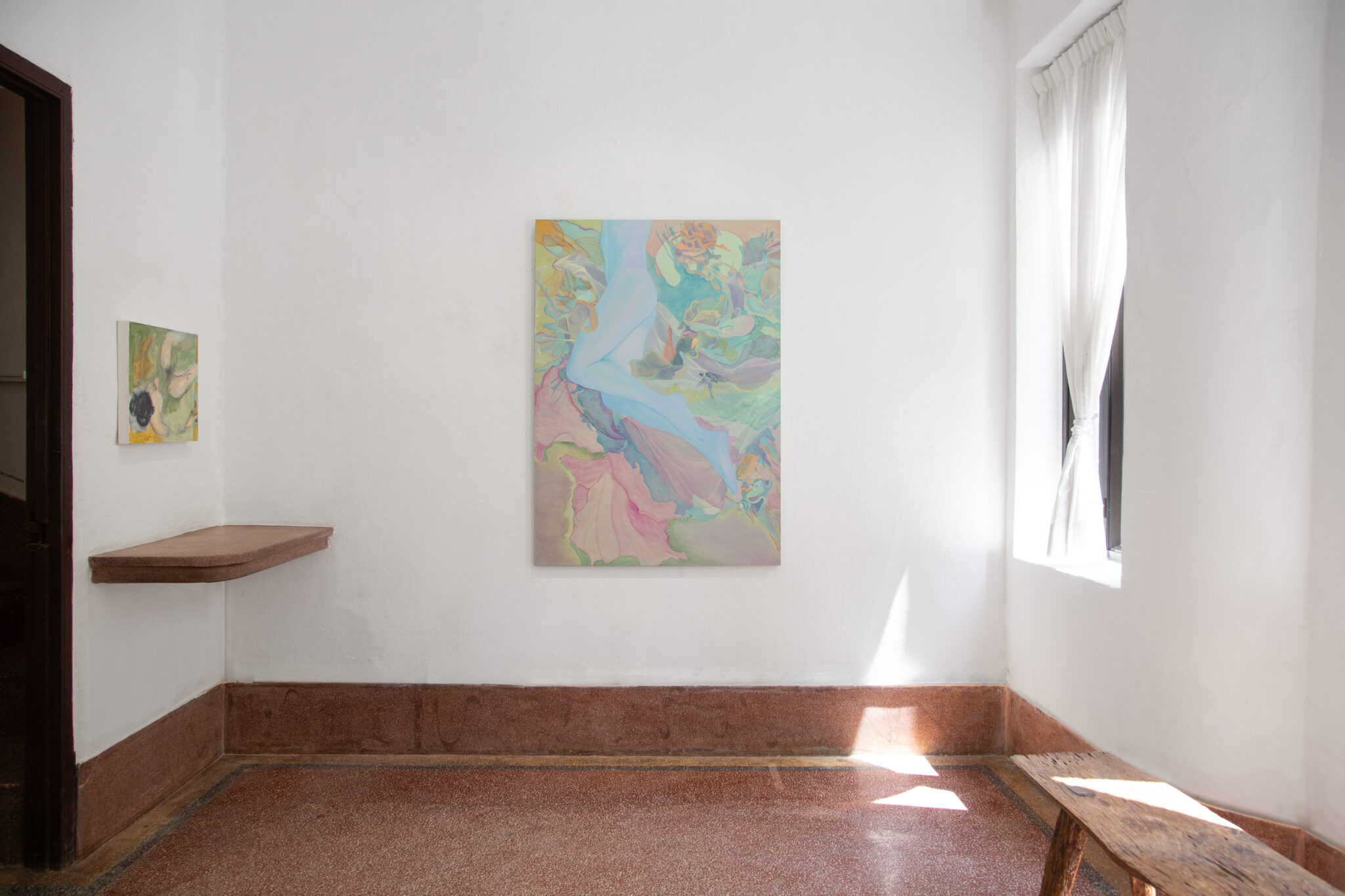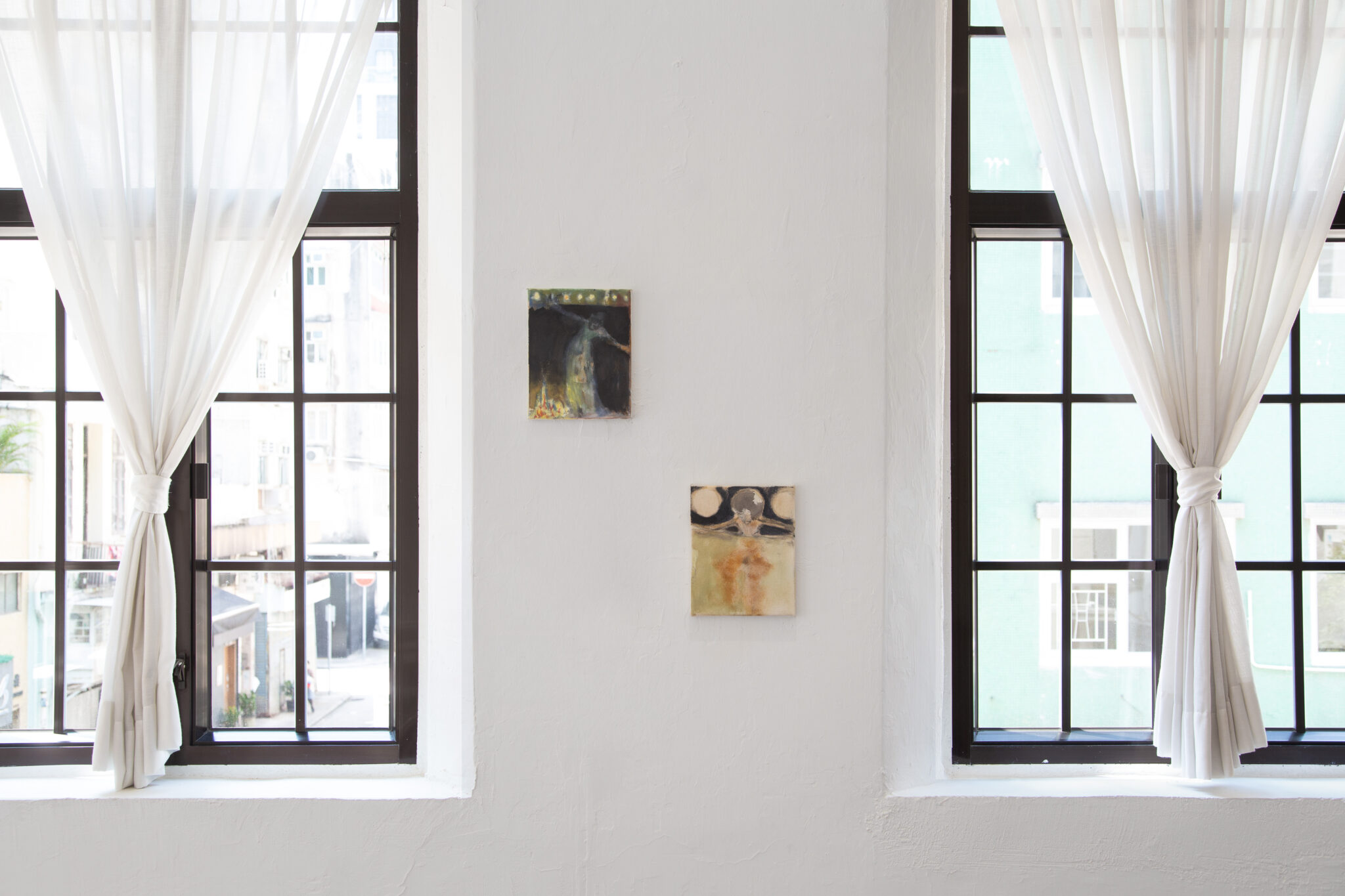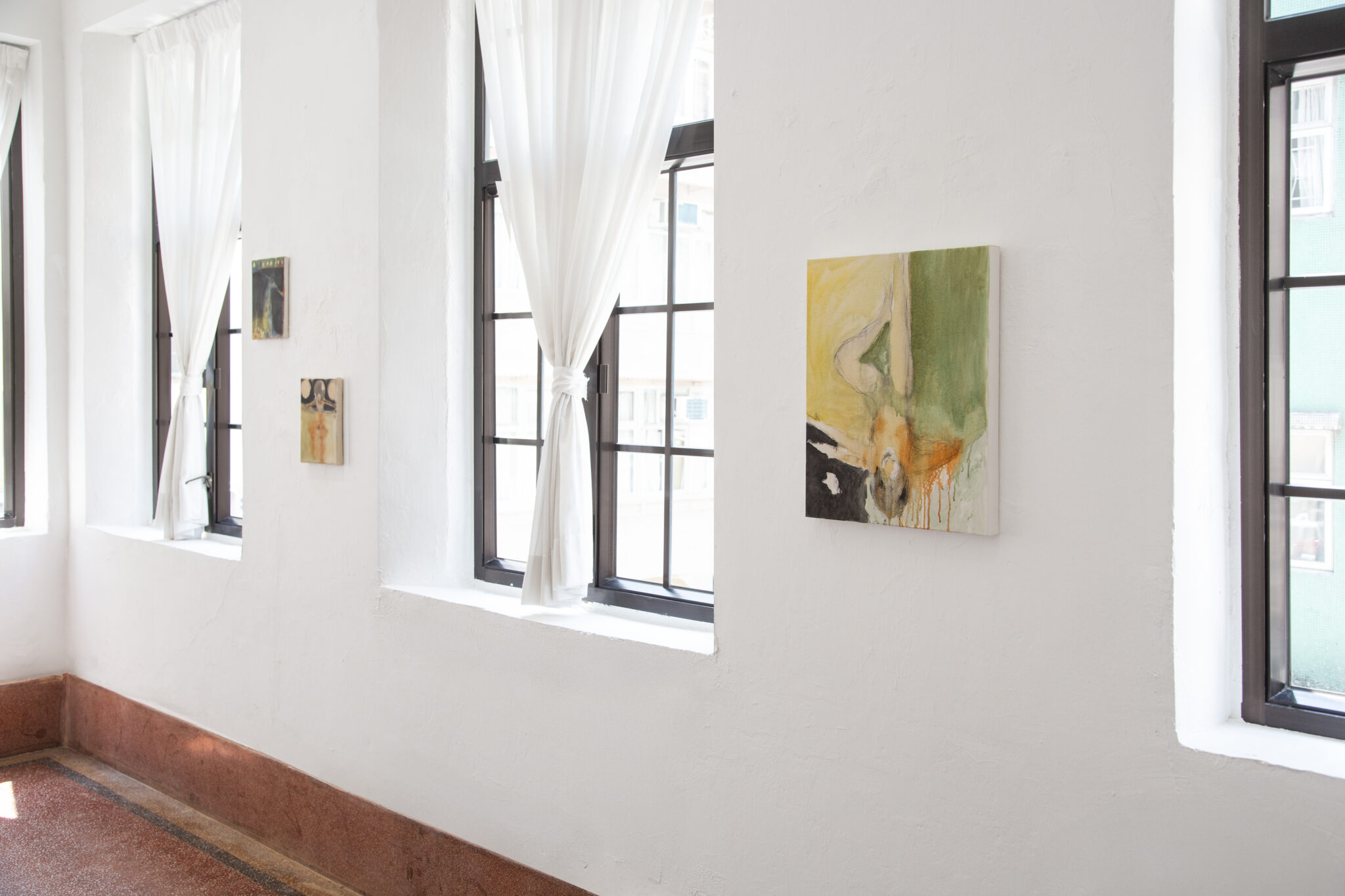Birth of Poetry
The body, celestial, attached by mire,
In the swarming tranquility of midnight,
Dawning with courage in the fresco of a tornado
THE SHOPHOUSE is pleased to present the group exhibition Birth of Poetry, featuring works by artists Chen Jinbin, Ted Gahl, Han Mengyun, Joy Li, Shi Zheng, and Zhang Ji. The exhibition explores the origins of poetry and its enduring significance in life, offering a glimpse into its primordial essence. Through a diverse range of mediums including painting, video, sculpture, and installation—the exhibition reveals how poetry emerges from the vastness of the cosmos, the quietude of the everyday, and the struggles of existence. Birth of Poetry opens on 22 March 2025 and runs through 11 May 2025.
Shi Zheng’s Celestial Fable contains a computer-generated poem that investigates the interplay between linguistic randomness and the cosmos. Inspired by Alison Knowles’ The House of Dust (1967), one of the earliest recorded computer-generated poems, Shi Zheng uses celestial as a metaphor for form, posing questions about its materials, temporal and spatial contexts, and emotional resonance. The work operates within a grammatical framework where four categories of words randomly combine to generate an endless sequence of poems. These poems describe celestial states, coordinates, and emotionally driven movements, pointing to various natural phenomena. Combining poetry, sound, and simulation, Celestial Fable triggers events on unknown planets, illustrating the profound connection between language and the universe.
Zhang Ji explores the macro-self through his paintings, which bear witness to the continuous process of creation through derivation and extension. Lines and forms in his works organically expand outward, mirroring the infinite unfolding of poetry itself. Zhang Ji’s paintings reveal how the artist uses visual language to express vast inner landscapes, uncovering the intrinsic link between poetry and the self.
Joy Li’s work focuses on the body and the everyday, revealing how poetry is born from the minutiae of life. She transforms intimate moments of daily perception into public markers—such as strands of hair clinging to bathroom tiles, their twisted forms resembling fragmented verses of handwritten poetry. Through various media, Joy redefines the boundaries of intimacy, immersing viewers in an unobstructed view of desire and sensory experience, capturing the flashbacks of specific moments in life.
Ted Gahl’s paintings explore the genesis of poetry through the synesthetic interplay of body and memory. Characterized by dreamlike textures and layered compositions, his works weave together sensory experiences and recollections. Ted Gahl’s practice functions as an emotional montage, merging past and present into a poetic whole, suggesting that poetry arises from the complex interaction between body and memory.
Chen Jinbin draws inspiration from the Interrupted Dream scene in the Chinese classics The Peony Pavilion. His series Love Without an Object reinterprets the tale of Du Liniang’s dreamlike encounter in the garden. Rather than adhering to the original characters or imagery, Chen Jinbin depicts the heroine’s emotional awakening in a new environment and bodily experience. The works capture the emergence of desire and the formation of objectless love, which grows like a fragmented yet infinitely expanding organism, seeking an outlet within confined spaces.
Han Mengyun’s work delves into how poetry is born from unfathomable darkness and hidden pain. Her multimedia installation Night draws inspiration from early Irish texts, which suggest that poetry originates in darkness. The installation features indigo-dyed fabric, painstakingly crafted by Dong women over nine months, hanging from a wooden ceiling structure. The near-black, deep blue fabric serves as a curtain of night, faintly glowing under dim light. The work creates a nocturnal theater that reflects theartist’s inner poetic vision, prompting viewers to contemplate the meaning of darkness: as the womb that harbors life andwisdom, as the veiled labor of women, and as a space for those who are hidden, confined, or abandoned. Yet, it also hints at the possibilities that darkness nurtures, suggesting hope even in the absence of light.
While Han Mengyun’s other work Confession: Prologue, is a video essay documenting her struggle with postpartum depression and her questioning of the maternal role. The video features rhythmic typing that fluctuates with her emotions, overlaid with an animated line drawing mimicking the gestures of her two-year-old daughter. By observing a newborn’s artistic exploration of the tangible and intangible world, Han Mengyun redefines the connections between art-making, life, and the act of giving birth.
Birth of Poetry offers a nuanced and multifaceted exploration of the genesis and sustenance of poetry as manifested through the diverse artistic practices of six contemporary artists. The exhibition delves into the myriad ways in which poetry emerges, evolves, and endures across varying contexts and mediums. From Zhang Ji’s expansive inner landscapes to Shi Zheng’s embrace of linguistic randomness, from Joy Li’s embodiment of the quotidian through the corporeal to Ted Gahl’s synesthetic recollections, from Chen Jinbin’s meditation on objectless love to Han Mengyun’s poetic force arising from concealed anguish, each artist contributes a unique lens through which the birth of poetry is articulated. The exhibition posits poetry not merely as a written or spoken form but as an omnipresent force that permeates the fabric of existence
身體、天體,被泥沼附著,
在午夜湧動的寧靜中,
在⿓捲⾵的壁畫中勇敢破曉。
THE SHOPHOUSE 欣然呈獻群展「詩歌的誕⽣」(Birth of Poetry),展出藝術家陳錦彬、泰德·加爾、韓夢雲、黎佳儀、施政和張季的作品,探索了詩歌的誕⽣及其在⽣命中的持久意義,試圖窺探它原始全貌的⼀⻆。 展覽以繪畫、影像、裝置等多重媒介,宏觀或微觀地揭示了詩歌如何從宇宙的壯闊、⽇常的靜谧與困境中誕⽣。 展覽將於2025年3⽉22⽇開幕,持續⾄5⽉11⽇。
施政的作品《天體寓⾔》通過計算機⽣成詩歌,探索了語⾔的隨機性與宇宙之間的聯繫。 受美國激浪派藝術家艾莉森·諾爾斯的《灰塵之屋》啟發,施政將「天體」作為「程式」的隱喻,設計了⼀個符合語法結構的機制,使四組特定⽂字中的獨立單元隨機相遇並排列組合,⽣成⼀組無⽌境的詩歌序列。 這些詩歌描述了天體的狀態、座標及由情緒引發的運動,指向不同的⾃然現象。 作品結合了詩歌、聲⾳與類比形式,每⼀段詩歌都觸發⼀個未知星球的事件,展現了語⾔與宇宙之間的深刻聯繫。
張季則通過繪畫探索巨集⼤的⾃我,他的作品⾒證了創作如何誕⽣於不斷的衍⽣與延伸。 線條與形式在他的繪畫中不斷向外有機地擴展,如同詩歌的誕⽣是⼀個無限延展的過程。 張季的作品展現了藝術家如何通過繪畫語⾔表達內⼼的巨集⼤景觀,揭示了詩歌與⾃我之間的內在。
黎佳儀的作品聚焦於⾝體與⽇常,揭示詩歌如何從⽣活的細微之處誕⽣。她將⽇常感知的私密瞬間轉化為公共空間中的記號——瓷磚上粘連的淋浴時掉落的頭發,扭曲盤旋的形態仿佛⼿寫下斷斷續續的詩句。黎佳儀通過多種媒介重新探索私密性的界限,將觀者浸潤於⼀覽無餘的欲望與感官感受之中,展現了⽣活中特定時刻的閃回。
泰德·加爾的作品通過⾝體與回憶的聯覺探索詩歌的⽣成。他的繪畫以夢幻般的質感與層次感為特征,展現了感官體驗與記憶的交織。加爾的作品如同⼀場情感的蒙太奇,將過去與現在融合為詩意的整體,暗示詩歌誕⽣於⾝體與記憶的復雜互動中。
陳錦彬的創作靈感來源於中國古典戲曲《牡丹亭》中的《驚夢》⼀折。他的作品系列《無客體的愛》重新詮釋了杜麗娘遊園驚夢的情節,描繪了女主⾓在新的環境與⾝體體驗下的情感覺醒。陳錦彬捕捉了情欲的發⽣與無客體愛的⽣成,這種情感如同碎⽚化卻無限⽣長的有機體,在逼仄的空間中蔓延並尋找出⼝。
韓夢雲的作品探討詩歌如何誕⽣於深不可測的⿊暗與隱痛。多媒體裝置《夜》從早期愛爾蘭⽂本中汲取靈感,將⿊暗視為詩歌的起源。裝置中,懸掛於⽊質天花板結構的侗族婦女⼿⼯染製的亮布,近乎發⿊的湛藍成為夜的幕布,在幽微的光線下隱隱發亮。韓夢雲試圖擬造⼀個反映其內⼼詩意願景的夜間劇場,引導觀眾反思⿊暗的意義:它是孕育⽣命與智慧的⼦宮,也是女性被遮蔽的勞作的象征。
另⼀件作品《⾃⽩:序》以散⽂視頻的形式記錄了韓夢雲作為⺟親與產後抑郁癥的⾾爭,以及對⺟親⾓⾊的質疑。影像中,⽂字敲打的節奏隨情緒波動起伏,疊加在滾動的⽂字之上的是⼀段純線條動畫,模仿她兩歲女兒畫畫的姿態。通過觀察⼀個空⽩的新⽣命以藝術的形式觸摸世界的有形與無形,韓夢雲重新理解了藝術、⽣命與⽣育之間的聯系與意義。
「詩歌的誕⽣」通過六位藝術家的多元實踐,展現了詩歌⽣成的多種可能性。從張季的宏⼤內⼼景觀到施政的語⾔隨機性,從黎佳儀的⾝體⽇常、泰德·加爾的聯覺記憶,陳錦彬的無客體之愛,到韓夢雲在隱痛中迸發的詩意⼒場,展覽揭示了詩歌如何在不同情境中誕⽣並持續影響⽣命。詩歌被書寫或被⾔說,同時它被感受、且在每⼀個存在的瞬間重新誕⽣。


